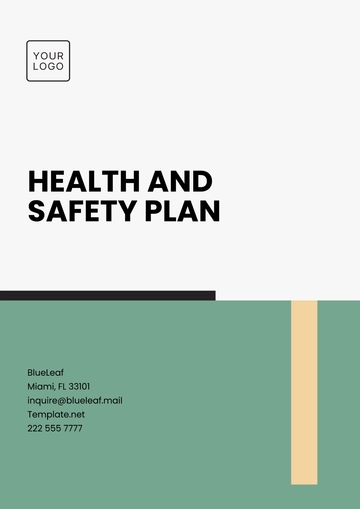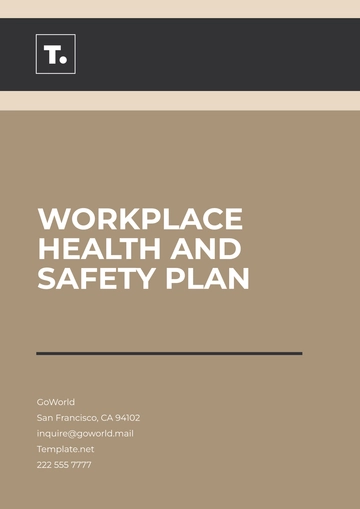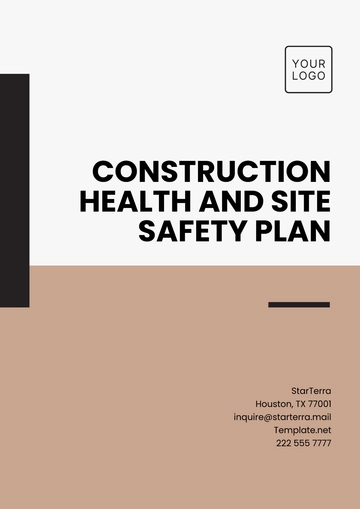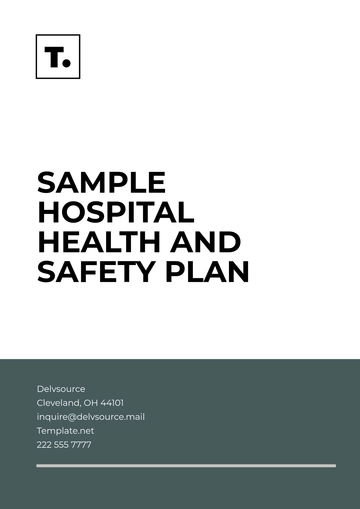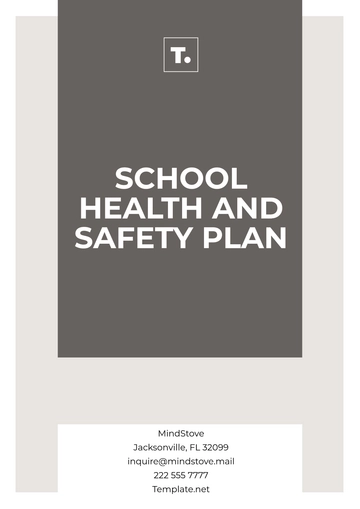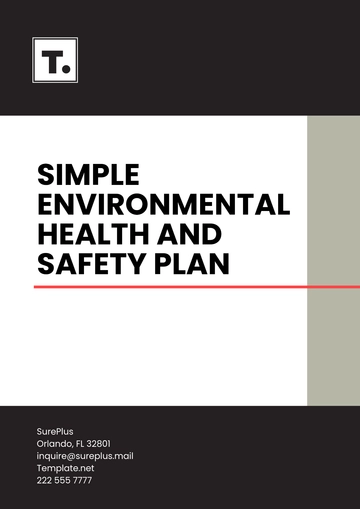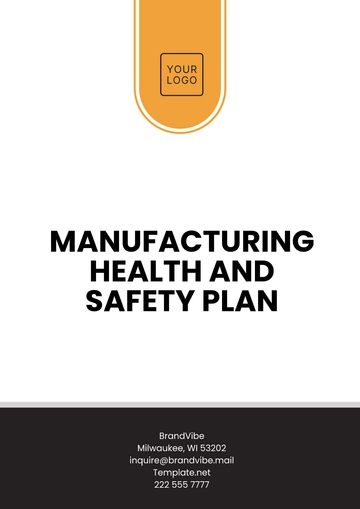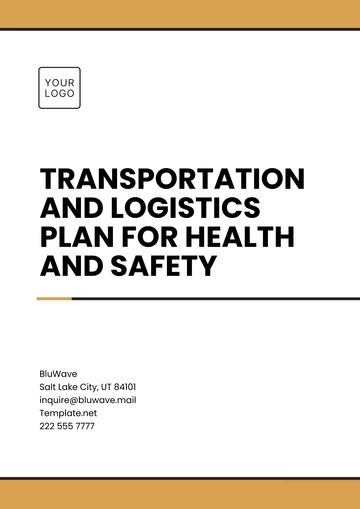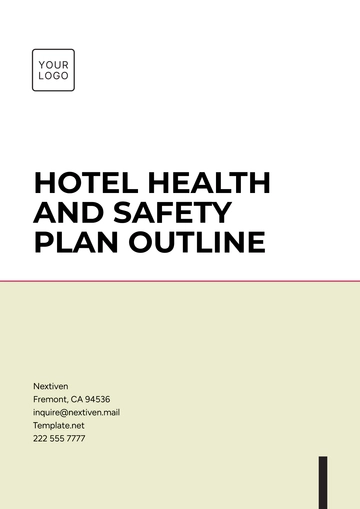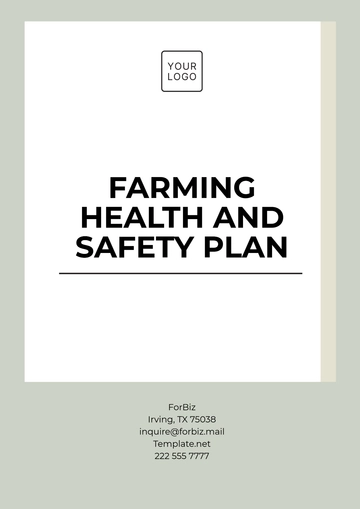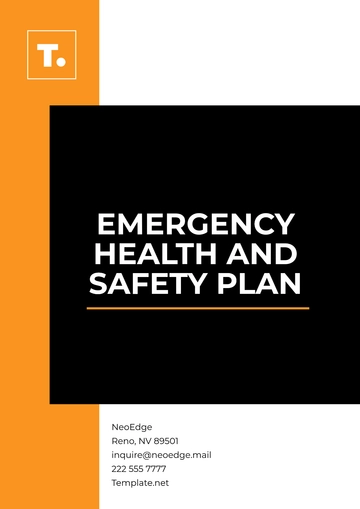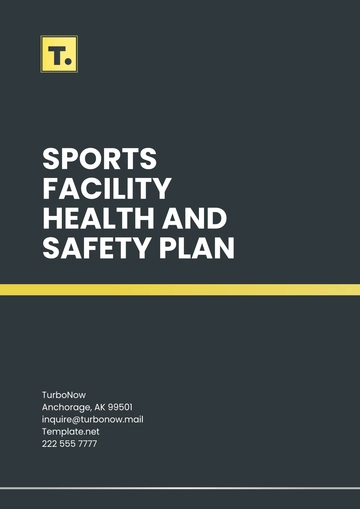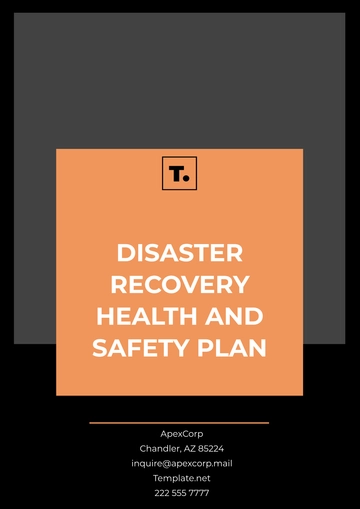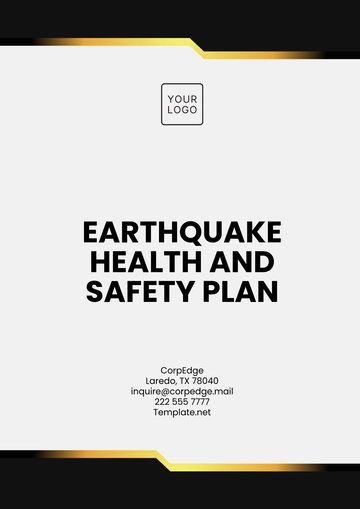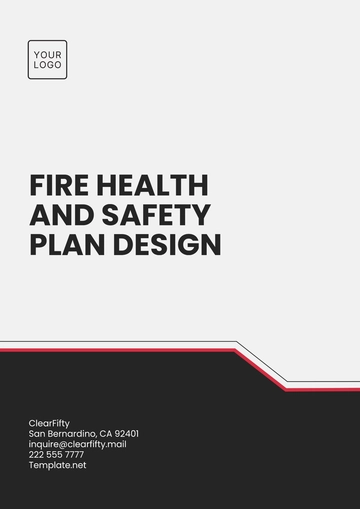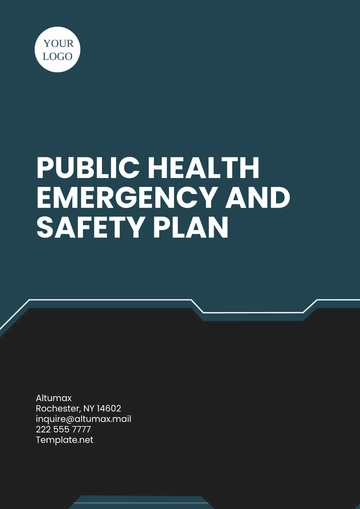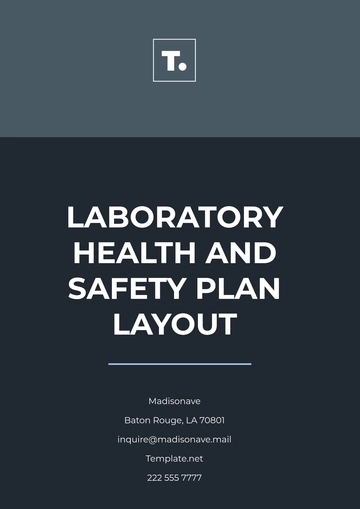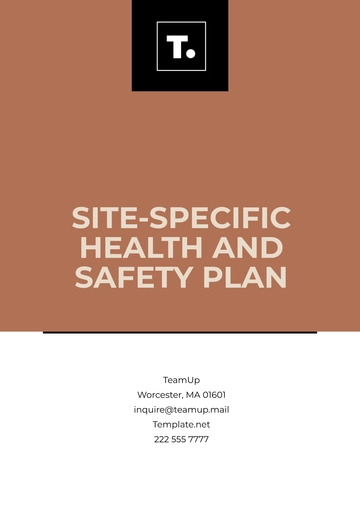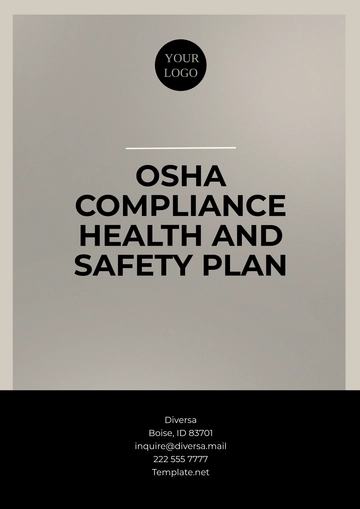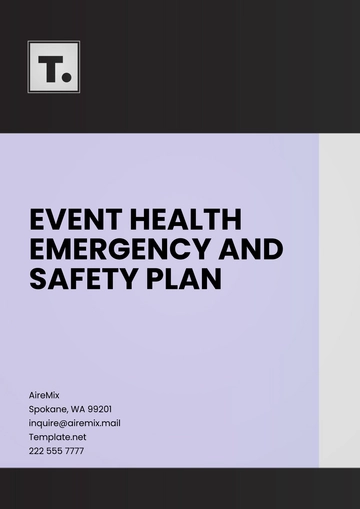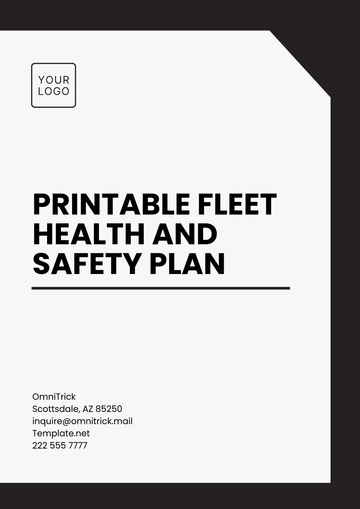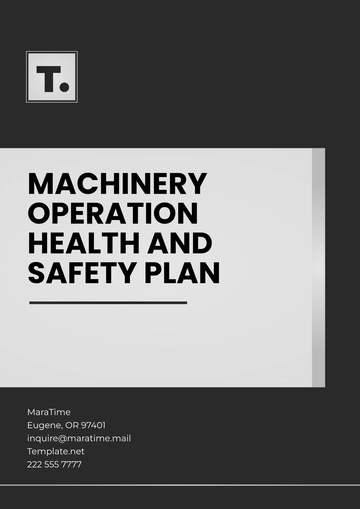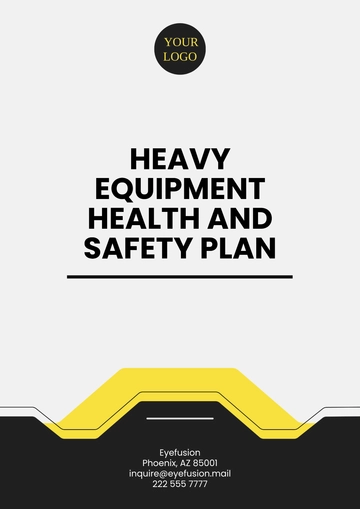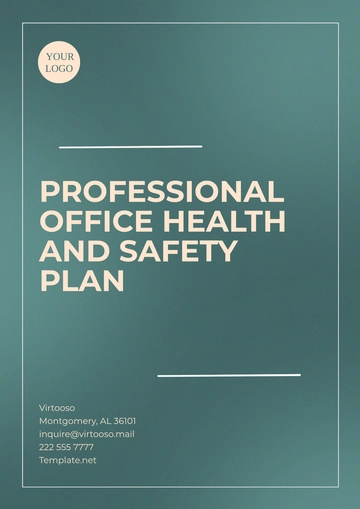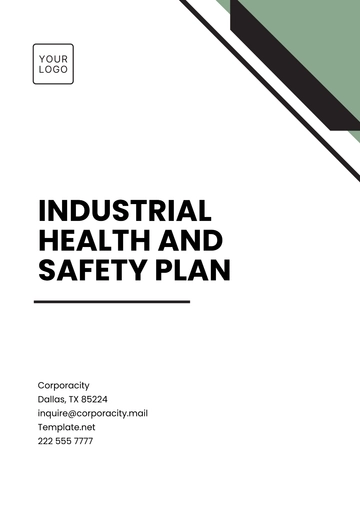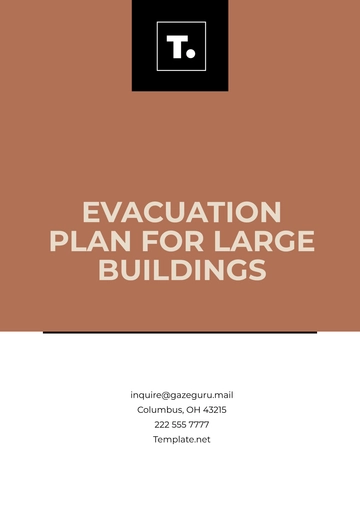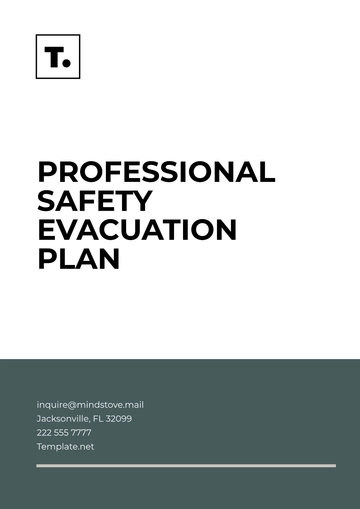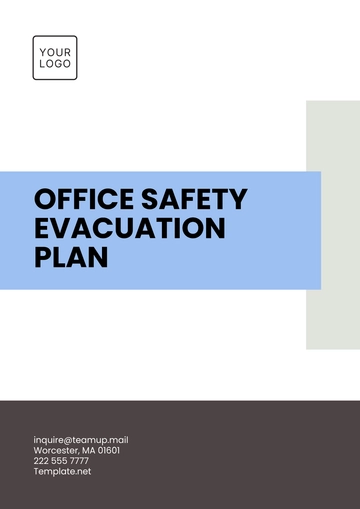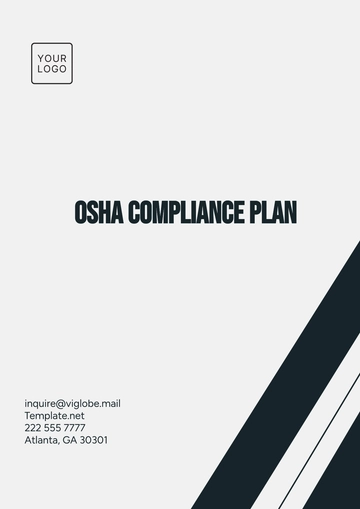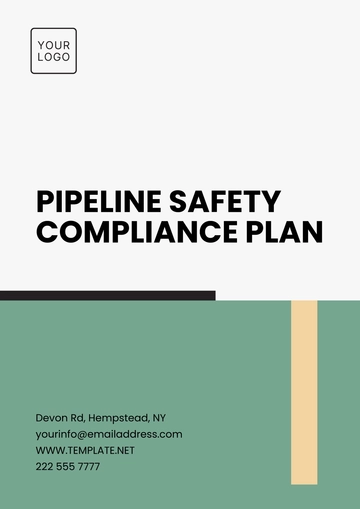Free Workplace Environmental Health and Safety Plan
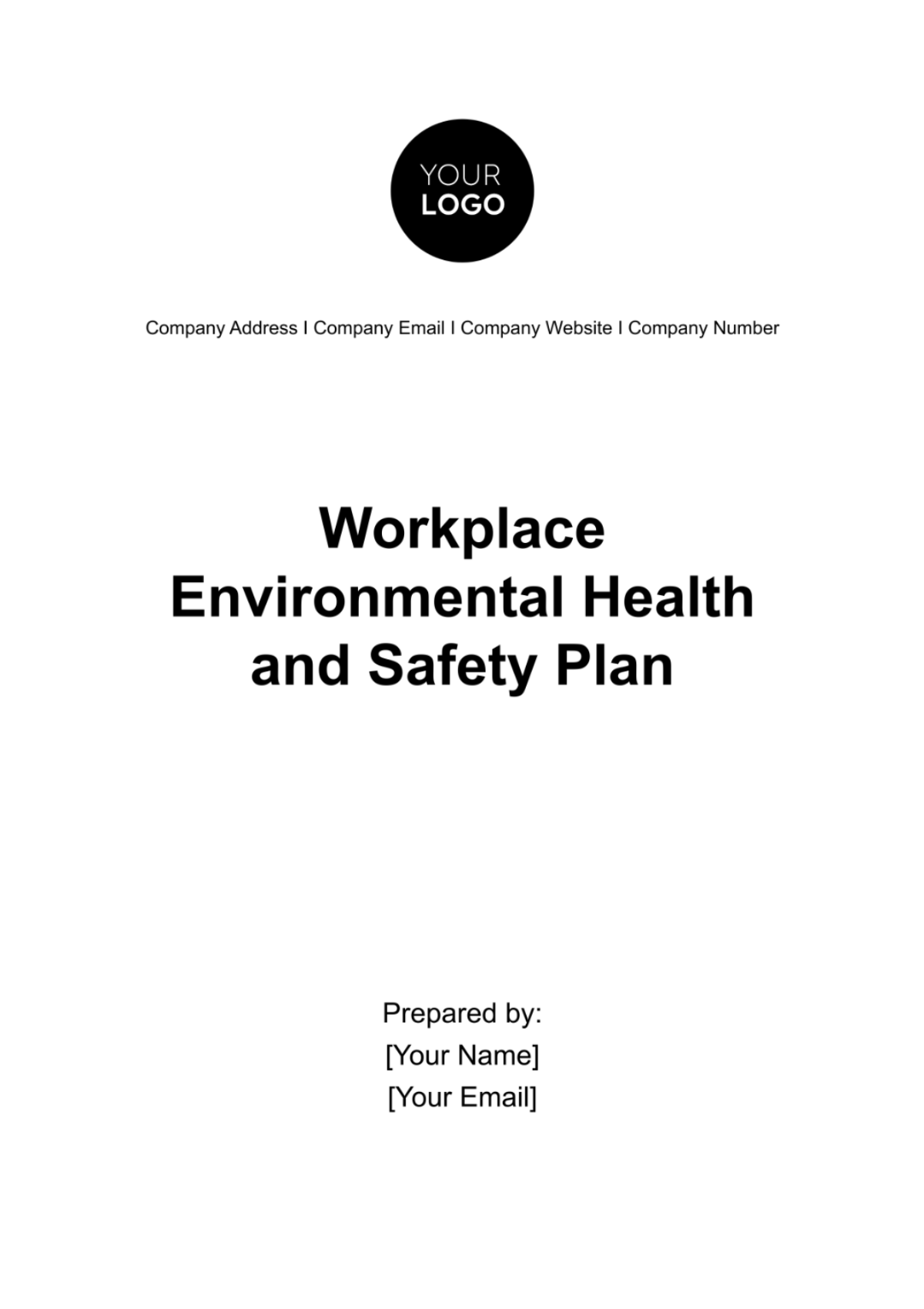
and Safety Plan
Introduction and Purpose
Overview of Health and Safety Policies
Purpose: To establish a proactive approach to health and safety, ensuring a safe working environment for all employees and visitors.
Scope: This policy applies to all employees, contractors, and visitors within the workplace, encompassing all operational areas.
Objectives of the Safety Plan
Establish a zero-tolerance policy towards workplace accidents and injuries.
Continuously improve the safety culture within the organization.
Scope and Applicability
This plan is applicable across all departments and job functions.
Organizational Responsibilities
Management Duties
Leadership Commitment: Top-level management demonstrates commitment to safety through policy development, resource allocation, and active participation in safety programs.
Resource Provision: Ensure the availability of financial, human, and physical resources to meet safety objectives, including safety equipment, training programs, and personnel.
Performance Monitoring: Regularly review safety performance metrics and implement changes as necessary.
Employee Responsibilities
Adherence to Safety Protocols: Employees must follow all safety guidelines and procedures, including the use of PPE and adherence to SOPs.
Active Participation: Engage in safety training, drills, and safety meetings. Provide feedback and suggestions for improving safety measures.
Incident Reporting: Promptly report accidents, near-misses, and safety hazards to supervisors or safety officers.
Safety Officers' Roles
Safety Audits and Inspections: Conduct regular safety audits and inspections to identify potential hazards and ensure compliance with safety protocols.
Safety Training and Education: Develop and deliver safety training programs. Keep records of training attendance and effectiveness.
Emergency Response Coordination: Lead emergency response efforts and ensure readiness through regular drills and updated emergency plans.
Risk Assessment and Management
Identification of Workplace Hazards
Regular Inspections: Conduct routine inspections of the workplace to identify potential hazards such as slip and trip hazards, electrical risks, and ergonomic issues.
Employee Input: Encourage employees to report hazards they observe. Provide anonymous reporting channels if necessary.
Risk Analysis and Prioritization
Risk Assessment Process: Utilize a structured approach to evaluate the severity and likelihood of identified hazards. This can involve checklists, interviews, and historical data analysis.
Prioritization Matrix: Develop a risk prioritization matrix to categorize risks and focus on the most critical issues first. This helps in allocating resources effectively.
Implementation of Control Measures
Mitigation Strategies: Develop strategies to mitigate identified risks, which may include engineering controls (e.g., machine guards), administrative controls (e.g., job rotation), and PPE.
Continuous Monitoring: Regularly monitor the effectiveness of implemented control measures and adjust as needed.
Risk Assessment Table
Hazard Type | Potential Risks | Control Measures |
Physical | Falls, machinery accidents | Guardrails, machine guards |
Chemical | Exposure to harmful substances | Ventilation systems, PPE |
Biological | Illness from bacteria/viruses | Sanitization procedures, PPE |
Ergonomic | Repetitive strain injuries | Ergonomic equipment, employee training |
Psychosocial | Stress, burnout | Employee counseling, workload management |
Training and Awareness
Safety Training Programs
Induction Training: New employees undergo a comprehensive safety induction program to familiarize them with workplace hazards and safety procedures.
Role-Specific Training: Tailored training programs for specific roles, particularly for employees in high-risk positions or those handling hazardous materials.
Refresher Training: Regularly scheduled refresher courses to keep all employees updated on safety protocols and procedures.
Emergency Procedures Training
Drill Schedules: Regularly scheduled drills for various emergency scenarios, including fire, natural disasters, and security threats.
Evacuation Procedures: Clear, well-communicated evacuation procedures, including designated routes and assembly points.
First Responder Training: Select employees receive advanced training to act as first responders in emergencies.
Continuous Education and Updates
Safety Bulletins and Updates: Regular communication of safety updates, new procedures, and lessons learned from safety incidents.
Feedback Mechanisms: Systems for employees to provide feedback on safety training and suggest improvements.
Monitoring Training Effectiveness: Evaluating the impact of training programs on safety performance and making adjustments as needed.
Training Record Table
Training Type | Frequency | Participation Rate |
Induction Training | On Hiring | 100% |
High-Risk Job Training | Annually | Target >90% |
Emergency Drill | Biannually | Target >95% |
Workplace Environment Management
Ergonomics and Workspace Design
Ergonomic Assessments: Regular assessments to identify and rectify ergonomic risks in workstations.
Workspace Design Improvements: Implementing changes in workspace design to enhance ergonomic safety, like adjustable chairs, desks, and computer equipment.
Air Quality and Ventilation
Air Quality Monitoring: Routine monitoring of air quality to detect pollutants and ensure compliance with health standards.
Ventilation System Maintenance: Regular maintenance and upgrades of ventilation systems to ensure optimal air quality.
Noise and Lighting Control
Noise Level Assessments: Conducting periodic assessments of noise levels and implementing control measures where necessary.
Adequate Lighting: Ensuring all work areas are well-lit to prevent eye strain and accidents, with regular maintenance of lighting systems.
Workplace Environment Metrics Table
Aspect | Standard | Current Status |
Ergonomics | Compliance with ergonomic guidelines | Ongoing assessments |
Air Quality | Meets health standards | Regular monitoring |
Noise Levels | Below regulatory limits | Periodic assessments |
Lighting | Adequate illumination | Continuous improvement |
Health and Safety Procedures
Standard Operating Procedures (SOPs)
Development and Accessibility: SOPs are developed for all critical tasks and are made easily accessible to all employees. They are regularly reviewed and updated.
Hazardous Material Handling: Specific SOPs for the safe handling, storage, and disposal of hazardous materials.
Incident Management Procedures: Clear procedures for managing safety incidents, including immediate actions, reporting, and follow-up.
Personal Protective Equipment (PPE) Usage
PPE Requirements: Detailed guidelines on the types of PPE required for various tasks and roles.
Training and Fit Testing: Ensuring that employees are trained on the proper use of PPE and that PPE is properly fitted.
Maintenance and Replacement: Regular checks and maintenance of PPE, along with a clear process for replacing worn or damaged equipment.
Incident Reporting and Investigation
Reporting Mechanisms: Easy-to-use channels for reporting incidents and hazards, including anonymous options.
Investigation Process: A step-by-step process for investigating incidents to identify root causes and prevent recurrence.
Documentation and Analysis: Maintaining records of all incidents and analyses to identify trends and areas for improvement.
Safety Procedures Compliance Table
Procedure Type | Compliance Rate | Action Plan |
PPE Usage | 95% | Increase training sessions |
Incident Reporting | 90% | Enhance reporting channels |
SOP Adherence | 88% | Conduct refresher courses |
Emergency Response and Preparedness
Emergency Plan and Evacuation Procedures
Plan Development: Comprehensive emergency plans covering a range of scenarios, including natural disasters, fires, and security threats.
Evacuation Drills: Regular evacuation drills to ensure all employees are familiar with emergency exits and assembly points.
Special Needs Consideration: Plans include provisions for employees with special needs or disabilities.
First Aid and Medical Assistance
First Aid Stations: Strategically located first aid stations, well-stocked and clearly marked.
Trained First Aiders: A sufficient number of employees trained in first aid, with their contact information widely available.
Emergency Medical Services Coordination: Procedures in place for quick coordination with external emergency medical services when needed.
Fire Safety Management
Fire Risk Assessment: Regular assessments to identify fire hazards and implement necessary controls.
Fire Safety Equipment: Maintenance and regular checks of fire extinguishers, alarms, and sprinkler system.
Fire Safety Training: Training programs on fire prevention, use of fire-fighting equipment, and evacuation procedures.
Emergency Preparedness Metrics Table
Emergency Type | Drill Frequency | Employee Participation |
Fire Evacuation | Quarterly | 100% |
Earthquake Drill | Biannually | 100% |
First Aid Response | Annually | Target >90% |
Health Surveillance and Medical Programs
Periodic Health Assessments
Regular Check-Ups: Schedule and conduct regular health screenings for employees, focusing on occupational health risks specific to their job roles.
Health Monitoring Records: Maintain confidential records of employee health assessments to track trends and identify potential occupational health issues.
Stress Management Programs
Stress Reduction Workshops: Organize workshops and training sessions on stress management techniques, work-life balance, and mental well-being.
Employee Assistance Programs (EAP): Provide access to counseling services and support for mental health issues, including stress and burnout.
Substance Abuse Policies
Clear Policies and Guidelines: Establish clear policies regarding substance abuse, outlining the consequences and support available.
Prevention and Education: Regular educational sessions on the risks of substance abuse and promotion of a drug-free workplace.
Health Program Participation Table
Program Type | Employee Participation | Frequency |
Health Screenings | 85% | Annually |
Stress Management Workshops | 75% | Biannually |
EAP Utilization | 40% | As needed |
Environmental Impact and Sustainability
Waste Management and Recycling
Recycling Initiatives: Implement comprehensive recycling programs for paper, plastics, and other materials.
Waste Reduction Policies: Adopt practices to reduce waste generation, including digital documentation to minimize paper use.
Energy Conservation Strategies
Energy Efficiency Audits: Regular audits to identify opportunities for energy savings in lighting, heating, and equipment use.
Renewable Energy Sources: Explore and implement the use of renewable energy sources where feasible.
Sustainable Resource Utilization
Sustainable Purchasing Policies: Implement policies to purchase environmentally friendly and sustainable materials.
Resource Conservation Practices: Encourage practices that conserve resources, such as water-saving fixtures and energy-efficient appliances.
Environmental Sustainability Metrics Table
Sustainability Aspect | Current Status | Annual Target |
Recycling Rate | 60% | Increase to 70% |
Energy Consumption | Baseline established | Reduce by 10% |
Sustainable Purchasing | 50% of supplies | Increase to 60% |
Monitoring, Review, and Continuous Improvement
Compliance Audits and Inspections
Regular Safety Audits: Conduct comprehensive safety audits to ensure compliance with internal policies and external regulations.
Inspection Reports: Document findings from safety inspections and audits, addressing any non-compliance issues promptly.
Review of Health and Safety Performance
Performance Metrics Analysis: Analyze key safety metrics to evaluate the effectiveness of safety programs and identify areas for improvement.
Employee Feedback Surveys: Conduct surveys to gather employee feedback on the safety culture and areas needing attention.
Plan Updates and Ongoing Improvement Initiatives
Continuous Improvement Cycle: Implement a continuous improvement cycle involving plan-do-check-act (PDCA) to regularly update and enhance safety procedures.
Stakeholder Involvement: Involve various stakeholders, including employees, in the review process to ensure diverse perspectives and comprehensive improvements.
Safety Performance Review Table
Metric | Current Performance | Target for Improvement |
Incident Rate | 2 incidents per 100 employees | Reduce to 1.5 |
Training Completion Rate | 90% | Increase to 95% |
Employee Safety Satisfaction | 80% positive feedback | Increase to 85% |
Conclusion
This Workplace Environmental Health and Safety Plan outlines a comprehensive strategy to ensure the safety, health, and well-being of all employees, while also addressing the environmental impact of workplace activities. The plan underscores the necessity of a proactive safety culture, consistent risk assessments, ongoing training, and adherence to established health and safety procedures.
Successful implementation of this plan demands commitment and collaboration across all organizational levels, from management to the workforce. It is essential to regularly monitor, review, and update the plan, adapting to evolving circumstances and striving for continual improvement in both safety and environmental performance.
Through the diligent application of this plan, the organization not only meets legal and regulatory obligations but also aims to exceed them, creating a workplace that is not just safe and compliant, but also exemplary in terms of health, safety, and environmental stewardship. The overarching aim is to foster an environment where safety and sustainability are integral to all operations, cultivating a culture where each employee actively contributes to maintaining and enhancing the workplace's safety and environmental standards.
- 100% Customizable, free editor
- Access 1 Million+ Templates, photo’s & graphics
- Download or share as a template
- Click and replace photos, graphics, text, backgrounds
- Resize, crop, AI write & more
- Access advanced editor
Revamp workplace safety with Template.net's Workplace Environmental Health and Safety Plan Template. This editable and customizable tool offers a comprehensive framework for crafting robust safety plans. With our intuitive Ai Editor Tool, tailor plans to your organization's unique requirements effortlessly, ensuring a safer and healthier work environment for all stakeholders.
You may also like
- Finance Plan
- Construction Plan
- Sales Plan
- Development Plan
- Career Plan
- Budget Plan
- HR Plan
- Education Plan
- Transition Plan
- Work Plan
- Training Plan
- Communication Plan
- Operation Plan
- Health And Safety Plan
- Strategy Plan
- Professional Development Plan
- Advertising Plan
- Risk Management Plan
- Restaurant Plan
- School Plan
- Nursing Home Patient Care Plan
- Nursing Care Plan
- Plan Event
- Startup Plan
- Social Media Plan
- Staffing Plan
- Annual Plan
- Content Plan
- Payment Plan
- Implementation Plan
- Hotel Plan
- Workout Plan
- Accounting Plan
- Campaign Plan
- Essay Plan
- 30 60 90 Day Plan
- Research Plan
- Recruitment Plan
- 90 Day Plan
- Quarterly Plan
- Emergency Plan
- 5 Year Plan
- Gym Plan
- Personal Plan
- IT and Software Plan
- Treatment Plan
- Real Estate Plan
- Law Firm Plan
- Healthcare Plan
- Improvement Plan
- Media Plan
- 5 Year Business Plan
- Learning Plan
- Marketing Campaign Plan
- Travel Agency Plan
- Cleaning Services Plan
- Interior Design Plan
- Performance Plan
- PR Plan
- Birth Plan
- Life Plan
- SEO Plan
- Disaster Recovery Plan
- Continuity Plan
- Launch Plan
- Legal Plan
- Behavior Plan
- Performance Improvement Plan
- Salon Plan
- Security Plan
- Security Management Plan
- Employee Development Plan
- Quality Plan
- Service Improvement Plan
- Growth Plan
- Incident Response Plan
- Basketball Plan
- Emergency Action Plan
- Product Launch Plan
- Spa Plan
- Employee Training Plan
- Data Analysis Plan
- Employee Action Plan
- Territory Plan
- Audit Plan
- Classroom Plan
- Activity Plan
- Parenting Plan
- Care Plan
- Project Execution Plan
- Exercise Plan
- Internship Plan
- Software Development Plan
- Continuous Improvement Plan
- Leave Plan
- 90 Day Sales Plan
- Advertising Agency Plan
- Employee Transition Plan
- Smart Action Plan
- Workplace Safety Plan
- Behavior Change Plan
- Contingency Plan
- Continuity of Operations Plan
- Health Plan
- Quality Control Plan
- Self Plan
- Sports Development Plan
- Change Management Plan
- Ecommerce Plan
- Personal Financial Plan
- Process Improvement Plan
- 30-60-90 Day Sales Plan
- Crisis Management Plan
- Engagement Plan
- Execution Plan
- Pandemic Plan
- Quality Assurance Plan
- Service Continuity Plan
- Agile Project Plan
- Fundraising Plan
- Job Transition Plan
- Asset Maintenance Plan
- Maintenance Plan
- Software Test Plan
- Staff Training and Development Plan
- 3 Year Plan
- Brand Activation Plan
- Release Plan
- Resource Plan
- Risk Mitigation Plan
- Teacher Plan
- 30 60 90 Day Plan for New Manager
- Food Safety Plan
- Food Truck Plan
- Hiring Plan
- Quality Management Plan
- Wellness Plan
- Behavior Intervention Plan
- Bonus Plan
- Investment Plan
- Maternity Leave Plan
- Pandemic Response Plan
- Succession Planning
- Coaching Plan
- Configuration Management Plan
- Remote Work Plan
- Self Care Plan
- Teaching Plan
- 100-Day Plan
- HACCP Plan
- Student Plan
- Sustainability Plan
- 30 60 90 Day Plan for Interview
- Access Plan
- Site Specific Safety Plan
